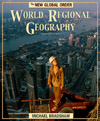 |  World Regional Geography: The New Global Order Update, 2/e Michael Bradshaw,
College of St. Mark and John
Basics of World Regional Geography
Chapter OutlineUse this outline to increase your understanding of the Basics of World Regional
Geography. - World Regional Geographic Enquiry -- Geographers study a wide variety of
factors to understand the characteristics of a place. Information is gathered
from many different sources and then analyzed using statistics and other methods
to answer important questions. Geographers often become involved in the issues
they are studying.
- Sense of Place: Location, Location, Location
- Location of Places -- Locations are often defined by latitude and longitude.
Locations are separated by distance and are different directions from each
other.
- Maps -- The various kinds of maps, like thematic or dot maps, show characteristics
of a portion of Earth's surface.
- Geographic Information Systems (GIS) -- Combining computers, data, and
locations, GIS are used to examine a wide variety of issues. Aerial photographs,
satellite images, and remote sensing techniques are also useful.
- Distributions, Density, and Diffusion -- The locations of phenomena are
distributed across space creating different densities. When locations change
it is the process of diffusion.
- World Population Geography: People Matter -- World population has grown
rapidly since the development of the Industrial Revolution.
- Population Distribution -- World population is distributed according to
the resources available in the natural environment and the level of available
technology. Many areas contain few people.
- Demography -- Births, deaths, and migration determine the demographic
characteristics of a region. The demographic transition suggests how economic
progress affects population growth.
- Population Policies -- Many countries believe slower population growth
is desirable, but the best ways to lower births are not always clear.
- World Political Geography: Countries and Governments -- The approximately
200 countries in the world today are the basic political unit used in studying
world regional geography.
- Nations and Nationalism -- A nation is not the same as a country. A nation
is group of people with common cultural features. Some countries contain
more than one nation. Nationalism is the desire to combine cultural and
territorial features.
- Governments -- Democratic, dictatorial, unitary, federal, and various
combinations are all different kinds of governments found in the world.
- Country Groupings -- Countries often join together for defense and/or
trade reasons. The European Union is the largest free-trade area.
- World Economic Geography: Wealth, Poverty, and Development -- Economics
and geography combine because production, distribution, and consumption occur
in patterns of locations.
- Economic Sectors -- The four sectors are known as the primary, secondary,
tertiary, and quaternary.
- Global Economy -- With capitalism becoming more dominant, multinational
corporations supported by better transportation and communication technologies
have become very important. Global financial and information services ease
the flows of money and information.
- Poverty and Development -- Studying patterns of economic conditions shows
large differences in wealth. Many geographers and the poor themselves are
very concerned with development as the way to improve the quality of life
for everyone. There are many different measures of development like the
Human Development Index and many different explanations or theories of how
development takes place. Structural adjustment or dual sectors are two possible
explanations. Civil wars, disease, and environmental stresses hamper development
efforts.
- Cultural Geography and World Regions -- Culture is passed from generation
to generation and includes several important elements.
- Language -- Language, the spoken means of communication among people,
is organized into language families based on specific areas of origin and
subsequent diffusion. Indo-European is the largest family.
- Religions -- Religion or an organized system of values and practices has
a lot of influence on how people live and respond to social issues. Christianity
including its three branches is the largest religion.
- Race, Class, and Gender -- A person's position in society is often affected
by race, class, and gender. Women are very important economically and socially,
but gender inequality continues around the world.
- Culture and Regions -- Major cultural differences stem from the cultural
hearths of history. Cultural fault lines sometimes exist between cultural
regions.
- Physical Geography and World Regions: Environmental Variations -- Earth's
natural environment is a dynamic system of interacting parts and varies from
region to region.
- Climatic Environments -- World climatic environments are derived from
differing transfers of heat and water within and between the atmosphere
and the oceans. These transfers are powered by solar energy. Global warming
is a significant example of humans impacting the environment.
- Shaping the Earth's Surface -- The location and nature of land masses
are the result of Earth's internal heat moving the tectonic plates. Weathering,
erosion, and deposition affect the character of the land surface.
- Plants, Animals, and Soils in Ecosystems -- Ecosystems contain living
organisms plus physical conditions like soils and climate. Biomes are global-sized
ecosystems. Soils and their fertility are crucial in determining agricultural
capabilities.
- Human Impacts -- Human activities have greatly affected the natural environment.
Ozone depletion and desertification are significant examples.
- Resources and Hazards -- Unevenly distributed, resources benefit some
regions more than others. Resources are either renewable or non-renewable.
Natural hazards like earthquakes are worse in some places than in other
places.
- How Many People Can Earth Support? -- Answers to political, economic, cultural,
and natural environmental questions are difficult to find, but are needed
to assess the carrying capacity of Earth.
- World Regional Landscapes -- Landscapes are usually visual.
- Urban Landscapes -- Buildings and transportation facilities dominate these
landscapes. New buildings change the older urban landscape.
- Rural Landscapes -- Fields, pastures, or natural environments dominate
rural landscapes.
|
|



 2002 McGraw-Hill Higher Education
2002 McGraw-Hill Higher Education